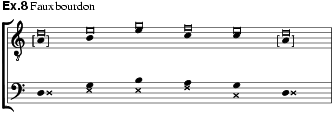
(fl late 15th century). ?Italian theorist. His nationality (or residence) can be deduced only from tenuous evidence: his differentiation of English and French practices from those ‘apud nos’; the location of the unique source of his work in Venice (I-Vnm lat.336); and the alleged similarity of his examples to the polyphonic laude of the time. His treatise, De preceptis artis musicae (ed. in Seay) seems to be a compilation, since its organization is unsystematic and repetitious, with examples misplaced or omitted and with inconsistencies between the examples and the text. Nevertheless, the work is of great importance because, in addition to practical matters of plainchant, modes, solmization and mensuration, he devoted several passages to gymel and fauxbourdon.
These techniques are presented in sections dealing with improvised counterpoint, for which Guilielmus gave rules and formulae. Descriptions of gymel and fauxbourdon occur first after the heading Ad habendum … cognitionem modi Anglicorum, and again after Incipiunt regulae contrapuncti Anglicorum; in a third discussion the styles described seem to be contrasted with the English versions. The relationship between gymel and fauxbourdon, and between the descriptions of each is extremely confused.
The first discussion is the simplest. Fauxbourdon, he said, consists of a ‘supranus’ and ‘contratenor’ improvised above a tenor cantus firmus. The supranus transposes an octave up from the melody it has ‘in sight’, which is a 3rd below the cantus firmus except at the beginning and cadences; ex.1a thus gives ex.1b. The contratenor sings a 3rd above the cantus firmus except at the beginning and cadences, as in ex.2. Combination of the two gives ex.3. This technique, with the cantus firmus in the lowest voice and using the transposition method of ‘sights’ described in earlier English treatises (see Sight, sighting), is clearly that which is nowadays usually called ‘extemporized English discant’. The term fauxbourdon is here used generically for extemporized polyphony. Gymel is described as the other method of fauxbourdon; its apparent relation to the technique previously described is that the supranus (a 3rd below in sight) and contratenor (a 3rd above) are conflated into a single voice singing a 3rd below or above the cantus firmus and, presumably, constantly crossing it in order to achieve the result in ex.4. Perhaps more likely is the reverse order of events, in which the added voice of gymel was expanded into the supranus and contratenor of three-voice discant: the contratenor itself eventually expanded into altus and bassus to create a four-part style described later by Guilielmus.




In his second discussion of the two styles, Guilielmus described the result of fauxbourdon (as in ex.3) without referring to the method of achieving it. A sentence preceding this description, ‘debet assumi supranum cantum firmum’, has sometimes been taken to mean that the supranus sings the cantus firmus and that therefore this type of fauxbourdon is quite different from the one first described, in which the tenor sang the cantus. But it is not clear that the sentence does in fact refer to the fauxbourdon description. Nor is the usual translation justified by the Latin, which appears to be corrupt. In view of this, there seems no reason to doubt that the style described here is the same as that described earlier. The brief reference to gymel in this second passage does not conflict with the earlier statement.
Guilielmus then described fauxbourdon ‘in another style, as used among us’. Here there are indeed implications that the cantus firmus lies in the supranus, which sets its sights on the ‘cantus firmus as it stands’ (‘tenendo proprium cantum firmum sicut stat’) rather than as in the earlier discant technique (ex.1): the supranus then applies octave transposition as before. The result (ex.5) is similar to ex.3 but uses sincopas per sextas et quintas to introduce some rhythmic variety, as in ex.6. Guilielmus said ‘this style is commonly called fauxbourdon’ and modern terminology agrees with him. According to Guilielmus it may have a contratenor altus and bassus, but the example given to illustrate that statement is not relevant.


The next passage, however, is concerned with a four-voice extemporized style which Guilielmus called gymel and which he related closely to fauxbourdon with altus and bassus. The rules for this technique are clear, and two different compositions result according to whether the starting point is gymel, which is ‘taken up above the cantus firmus … in 6ths and octaves’, or fauxbourdon, which has the cantus firmus in the top voice (exx.7 and 8). Both of these pieces, progressing by chords in root position, are close to the Italian Falsobordone style found written out in some contemporary sources.


To summarize, Guilielmus first used the term ‘fauxbourdon’ to mean extemporized polyphony and included under the term a description of parallel discant and of gymel, both sung by the English. The crucial sentence ‘debet assumi supranum cantum firmum’ must be a corruption, perhaps of ‘debet assumi supra eum cantum firmum’: discant is indeed performed ‘above its cantus firmus’. He went on to describe fauxbourdon ‘apud nos’, with the cantus in the top voice, a style that agrees with continental practice. Finally he described two forms of four-voice extemporization which differ in the placing of cantus firmus in tenor or top voice.
M.F. Bukofzer: Geschichte des englischen Diskants und des Fauxbourdons nach den theoretischen Quellen (Strasbourg, 1936/R)
J. Handschin: ‘ Eine umstrittene Stelle bei Guilelmus Monachus’, IMSCR IV: Basle 1949, 145–9
H. Besseler: Bourdon und Fauxbourdon (Leipzig, 1950, rev., enlarged 2/1974 by P. Gülke)
A. Seay, ed.: Guilielmi Monachi De preceptis artis musicae, CSM, xi (1965)
E. Apfel: ‘Nochmals zum Fauxbourdon (Faburden) bei Guilielmus Monachus’, Mf, xix (1966), 284–5
A.B. Scott: ‘ The Beginnings of Fauxbourdon: a New Interpretation’, JAMS, xxiv (1971), 345–63
M. Jans: ‘Alle gegen Eine: Satzmodelle in Note-gegen-Note-Sätzen des 16. und 17. Jahrhunderts’, Basler Jb für historische Musikpraxis, x (1986), 101–20
E. Park: ‘De preceptis artis musicae’ of Guilielmus Monachus: a New Edition, Translation, and Commentary (diss., Ohio State U., 1993)
For further bibliography see Fauxbourdon and Faburden.
ANDREW HUGHES